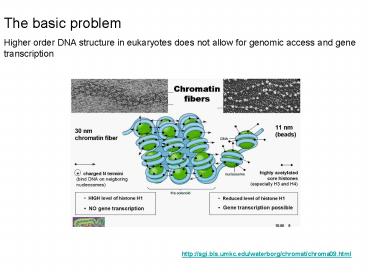http:sgi'bls'umkc'eduwaterborgchromatchroma09'html - PowerPoint PPT Presentation
1 / 9
Title:
http:sgi'bls'umkc'eduwaterborgchromatchroma09'html
Description:
Higher order DNA structure in eukaryotes does not allow for genomic access and ... Properties of PcG and TrxG proteins ... Post translational modification of histones ... – PowerPoint PPT presentation
Number of Views:33
Avg rating:3.0/5.0
Title: http:sgi'bls'umkc'eduwaterborgchromatchroma09'html
1
The basic problem Higher order DNA structure in
eukaryotes does not allow for genomic access and
gene transcription
http//sgi.bls.umkc.edu/waterborg/chromat/chroma09
.html
2
The basic problem Higher order DNA structure in
eukaryotes does not allow for genomic access and
gene transcription
http//www.abcam.com/cms/displayImage.cfm?intImage
ID6801
3
Proteins with this types of activity were
originally identified in a Drosophila genetic
screen
Homeotic (hox) genes control segmentation in the
fly, and are organized in clusters at the
genomic level (common regultory elements)
Screens identified genes which were broadly
grouped into two groups based on their activity
on transcription of Hox clusters
PcG- polycomb group- Act as repressors of hox
gene transcription TrxG- trithorax group
Derepress (activate) hox gene transcription
Lack of intergenic complementation suggested
early on that these factors acted in multimeric
complexes ie. Compound heterozygotic mutants had
enhanced homeotic phenotypes
4
Properties of PcG and TrxG proteins
Subsequent to their characterization in
regulation of Hox gene expression these factors
were shown to regulate large numbers of genetic
loci Highly conserved mechanism yeast to humans
Function in large multimeric complexes with
elements having distinct responsibilities
Must bind polycomb (PRE) and Trithorax (TRE)
response elements to gain proximity to histones
(DNA binding proteins included in complexes)
Once bound PcG and TrxG complexes regulate
genomic accessibility by
- Post translational modification of histones
- Regulation of chromatin structure (histone
displacement and reassembly) - Regulate the 3D organization of PREs anf TREs
5
How is chromatin structure regulated to
allow/restrict access of transcriptionally active
proteins to DNA?
- Postranslational modifications of histones
(acetylation, phosphorylation, methylation,
ubiquintination) primarily occurs in regulatory
regions - Tags mark DNA for recognition by complexes that
can transform DNA from a repressive state to a
permissive state. - Modifications can alter access/readiness in
regulatory regions but alone are not sufficient
to promote histone displacement, a necessary
component of gene transcription
- Chromatin remodeling complexes
- Displace one or multiple core histones (also
mediate reassembly) - ATP dependent
- Activity results in structural changes to
chromatin
6
PcG and TrxG Broad classification for proteins
with many types of activities
Tyler and Kodonga Cell 99 Nov 1999
Grimaud et al Chrom. Res. 142006
7
The Polycomb group protein Eed protects the
inactive X-chromosome from differentiation-induced
reactivation Sundeep Kalantry,1 Kyle C. Mills,1
Della Yee,1 Arie P. Otte,2 Barbara Panning,3 and
Terry Magnuson1 1 Department of Genetics and
the Carolina Center for the Genome Sciences,
University of North Carolina, Chapel Hill, North
Carolina 27599-7264, USA. 2 Swammerdam Institute
for Life Sciences, University of Amsterdam, 1098
SM Amsterdam, The Netherlands. 3 Department of
Biochemistry and Biophysics, University of
California San Francisco, San Francisco, CA
94143, USA.
G. Strathdee and R. Brown Exp. Rev. in Mol. Med
March 2002
8
G. Strathdee and R. Brown Exp. Rev. in Mol. Med
March 2002
9
Chromatin remodeling factors are multiprotein
complexes that use the energy of ATP hydrolysis
to alter the architecture of chromatin at the
nucleosomal level.
BRG1 is a catalytic subunit of a Swi/Snf related
compled
Johnson et. al. Biochem. cell bio. Aug 2005































